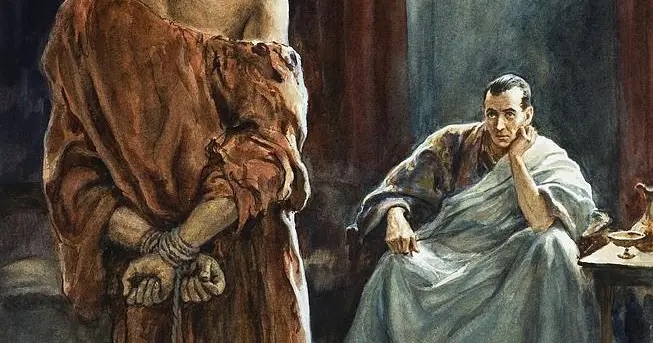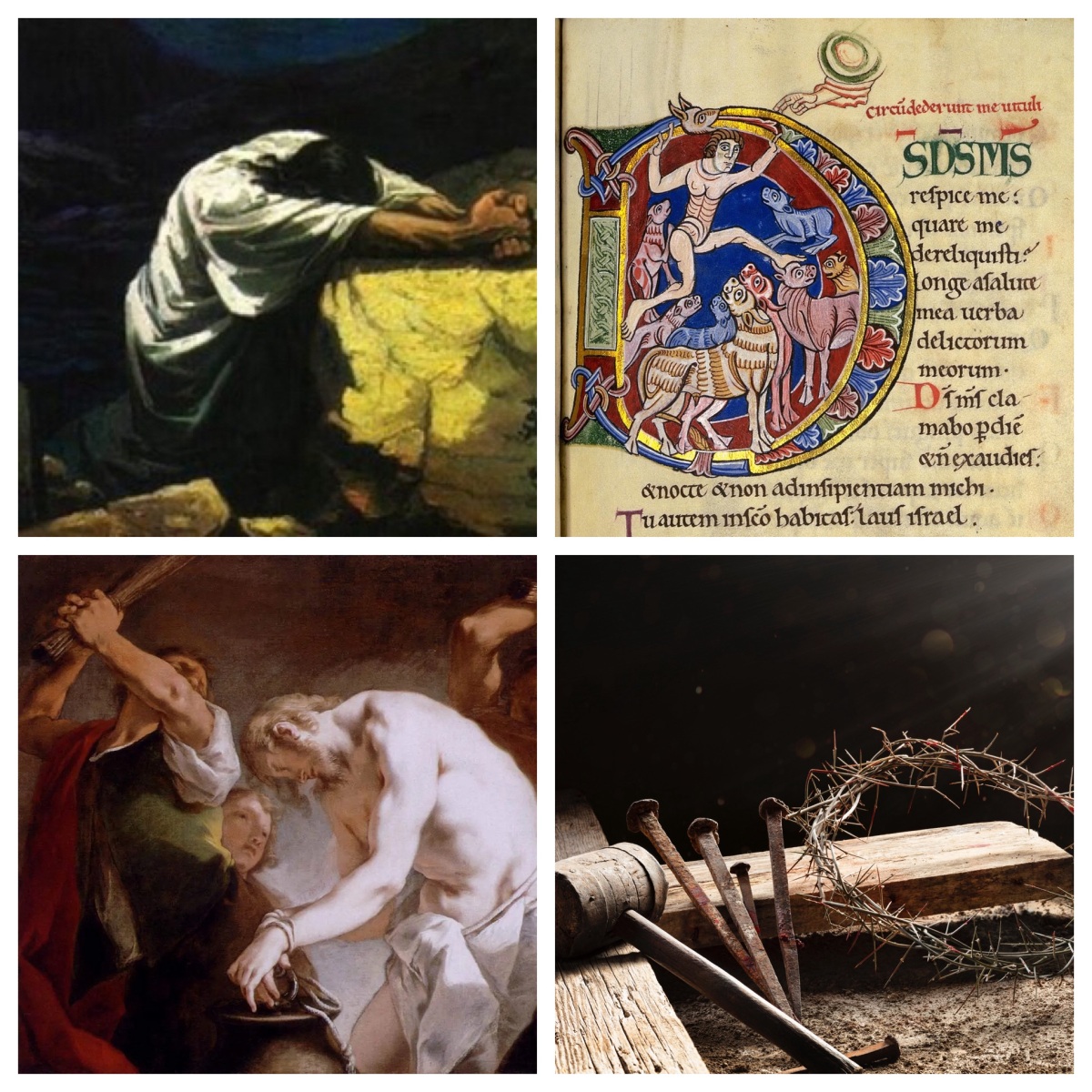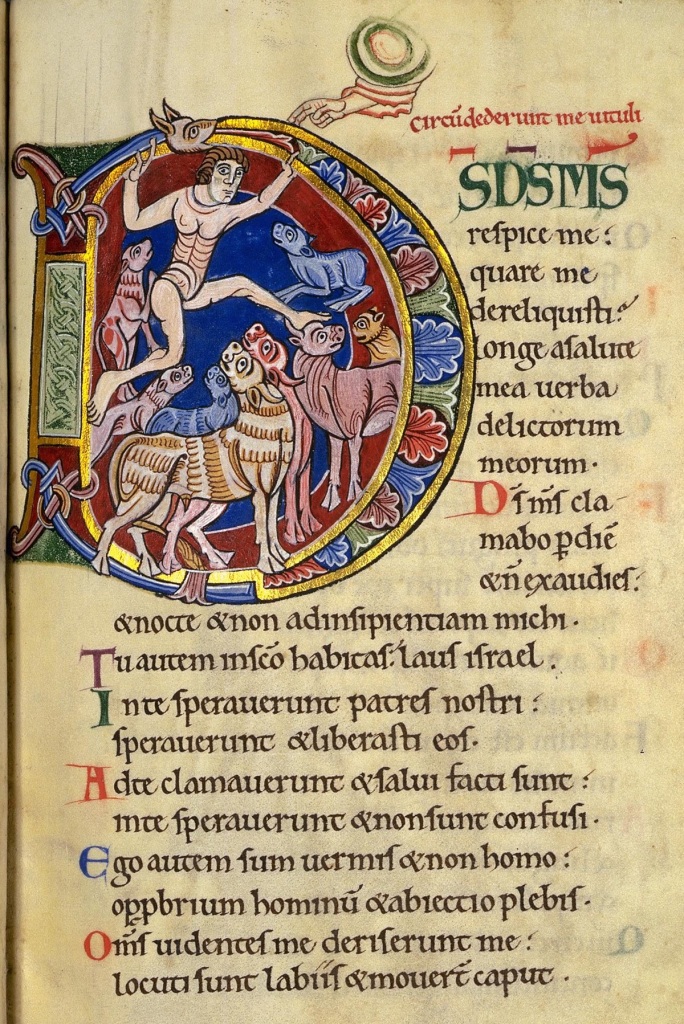“What do you wish me to do?”, Pilate asks—according to the earliest account of his interaction with Jesus of Nazareth, recounted in the Gospel we attribute to Mark (although the narrative itself refrains from offering any identification of the author). Pilate, the Governor, representative of the mighty Roman Empire, asking a rag-tag crowd of Jews for advice on what he should do? Is there any historical plausibility in this scene which the unknown first century writer constructs?
I have had a number of discussions of this issue with my wife, Elizabeth Raine, whose knowledge of ancient authors and ancient Roman practices has been illuminating for the way we might understand the Gospel accounts. Much of what follows reflects those discussions.

“What do you wish me to do?” (Mark 15:12). It is not only this question that should cause us to question the narrative. Earlier, Pilate had seemed at a loss: “do you want me to release for you the King of the Jews?” (15:9). The narrative offers an explanation: “he realized that it was out of jealousy that the chief priests had handed him over” (15:10). And then it presses the point: “the chief priests stirred up the crowd to have him release Barabbas for them instead” (15:11), and so he asks the crowd, “what do you want me to do?” (15:12). For us, the question is: what do we make of this dithering, indecisive Pilate?
The narrative plays out the conflict by making sure that we understand Pilate has been cowed by the crowd, reporting that the crowd shouted at the Governor, “Crucify him!” (15:13). Instead of portraying the Governor as responding with all his imperial might, the narrative continues with Pilate asking a naïve question, “Why, what evil has he done?” (15:14a). To this, the crowd pressed still louder, “Crucify him!” (15:14b). And so, the denouement plays out: “Pilate, wishing to satisfy the crowd, released Barabbas for them; and after flogging Jesus, he handed him over to be crucified” (15:15).

We know that the Gospels were not written as “eye-witness accounts”. It would especially have been unlikely that one of the followers of Jesus was there, taking notes, as Pilate dealt with Jesus Barabbas and Jesus of Nazareth. The unlikelihood of this slim possibility is intensified by the comment in Mark’s Gospel, about the followers of Jesus, that “all of them deserted him and fled” (14:50). Clearly, the author envisages that none of those followers were there at this scene. (The reference to a group of women “who used to follow him and provided for him when he was in Galilee” refers, not to this moment in the sequence of events, but only to the later scene when Jesus is dying on the cross; see 15:40–41.)
We can’t treat the Gospels as actual “history-as-it-took-place”. We can’t treat the Markan account of Jesus before Pilate as historical. That is especially the case regarding the way that Pilate is portrayed. Most of our knowledge of Pilate outside the New Testament comes from the writings of the Romano-Jewish historian Flavius Josephus, who details many incidents during the governorship of Pilate, and Philo Judaeus, a learned Jewish philosopher living in diaspora in his Alexandria. The Pilate they describe is quite different.
Their Pilate is said to have displayed a serious lack of empathy for Jewish sensibilities, for example by displaying Roman battle standards in Jerusalem. Josephus writes, “On one occasion, when the soldiers under his command came to Jerusalem, he caused them to bring with them their ensigns, upon which were the usual images of the emperor. The ensigns were brought in privily by night, but their presence was soon discovered. Immediately multitudes of excited Jews hastened to Caesarea to petition him for the removal of the obnoxious ensigns. For five days he refused to hear them, but on the sixth he took his place on the judgment seat, and when the Jews were admitted he had them surrounded with soldiers and threatened them with instant death unless they ceased to trouble him with the matter.”
The story does end with Pilate backing down; but this is in the face of a large uprising, and not just in relation to one individual. Josephus continues, “The Jews thereupon flung themselves on the ground and bared their necks, declaring that they preferred death to the violation of their laws. Pilate, unwilling to slay so many, yielded the point and removed the ensigns.” (Josephus, Jewish War 2.169–174; Antiquities of the Jews 18.55–59)
Philo of Alexandria tells us that on other occasion Pilate dedicated some gilt shields in the palace of Herod in honour of the emperor. On these shields there was no representation of any forbidden thing, but simply an inscription of the name of the donor and of him in whose honour they were set up. The Jews petitioned him to have them removed; when he refused, they appealed to Tiberius, who overrode the governor, ordering that they should be removed to Caesarea. (Philo, Legatio ad Gaium, 38)
Josephus also reports how Pilate appropriated Temple funds for the construction of an aqueduct: “At another time he used the sacred treasure of the temple, called corban (qorban), to pay for bringing water into Jerusalem by an aqueduct. A crowd came together and clamoured against him; but he had caused soldiers dressed as civilians to mingle with the multitude, and at a given signal they fell upon the rioters and beat them so severely with staves that the riot was quelled.” (Josephus, Jewish War 2.175–177; Antiquities of the Jews 18.60–62)
Pilate may possibly have responded harshly to the unrest in Jerusalem during the Passover in 33 CE, because, due to other political machinations at that time, the powerful neighbouring Roman province of Syria was unable to provide him military support, as usual. (This the hypothesis that Elizabeth has developed; I think it makes sense.) Pilate wanted to suppress the potential uprising before it got momentum.
We do know that in approximately 36 CE, Pilate used arrests and executions to quash a Samaritan religious uprising. After complaints were then made to the Roman legate of Syria, Pilate was recalled to Rome; he is believed to have later committed suicide.
So, we can see that the character of Pilate in other ancient texts beyond the earliest Christian texts is far more ferocious and determined than how he is depicted in the Gospels; and, indeed, he is antagonistic towards Jews in particular. His vascillation, and his bowing to the shouted demands of the crowd, do not correlate with the character of the figure to which these two Jewish writers attest.
Thus, there is a clear political improbability to the account found in Mark’s Gospel—indeed, in all four Gospels, whose authors each strengthen the Markan portrayal. Matthew has Pilate wash his hands of his decision, saying, “I am innocent of this man’s blood; see to it yourselves” (Matt 27:24). Luke has Pilate declare that Jesus was innocent not once, but three times (Luke 23:4, 14, 22). And John’s Pilate engages in a philosophical discussion with Jesus (John 18:33–38) and questions him further, seeking to find a way to excuse him (John 19:8–12), before bowing to the pressure of the crowd (John 19:13–16).

So Pilate as we know him from other accounts was a ferocious and fearless leader whose strength of character is made clear by the numerous times that, according to Josephus, he sent in his troops to quell an uprising, to scatter a crowd, to squash a rebellion.
American scholar Bart Ehrman concludes that Pilate “was a brutal, ruthless ruler with no concerns at all for what the people he governed thought about him or his policies. He was violent, mean-spirited, and hardheaded. He used his soldiers as thugs to beat the people into submission, and he ruled Judea with an iron fist.” (See https://www.patheos.com/blogs/rationaldoubt/2019/05/pilate-released-barabbas-really/)
Surely Pilate would not have been cowed by the crowd in Jerusalem for Passover? Had he wanted to act, he would simply have ordered his troops to attack, scatter the crowd, and disperse the built-up tension. The Gospel accounts of Pilate, across all four narratives, are improbable; the apologetic purpose (to show the Romans in a better light, to avoid being seen as an agitator or rebel, and to place the blame on the Jewish authorities) becomes clear, when we read in this way. We need to bear all of this in mind, as we read and listen to the familiar narrative this Easter, and each Easter.
Would a Roman Governor ask a Jewish crowd for advice? That would be an untenable act, completely undermining his authority. Would a Roman Governor release a known insurrectionist from his sentence? There is no known precedent for this—indeed, no evidence at all, apart from the Gospels, of this practice. It is historically implausible (particularly in the light of the fact that Barnabas means “son of God”).
On the (mythological) story of Barabbas:
Would a Roman Governor be so under the control of the Jewish Sanhedrin to act in this way? Especially since it was Rome which appointed the High Priest; it was the Jewish hierarchy which needed to do as Rome commanded. In the earliest account, Pilate questions the crowd as to whether he should sentence Jesus (Mark 15:5, 14). The same question is noted in Matt 27:23. By the time of Luke’s Gospel, he speaks a clear threefold affirmation of the innocence of Jesus (Luke 23:4, 13–16, 22).
By the fourth Gospel, the scene where Jesus is brought to Pilate is changed from a trial to a philosophical discussion (John 18:29–31, 38). Pilate (quite uncharacteristically) backs down in the face of a baying crowd (Mark 15:6-15, and parallels). In Matthew’s account, Pilate enacts the potent symbol of washing his hands of the whole affair (Matt 27:24).
The Jewish Sanhedrin, by contrast, is placed firmly in the firing line. All four Gospels tell the story in the same way: the central factor that leads to Jesus being condemned to death is the decision of the Jewish Sanhedrin (Mark 14:63-64, and parallels), and their agitation amongst the crowd (Mark 15:11; Matt 27:20; Luke 23:13-16; John 18:38b-40). Mind you, the Gospel accounts are also on shaky historical ground in the way they describe the actions of the Sanhedrin. See
So another relevant question is: Would a follower of a man put to death under Roman rule for treason write a narrative which placed the blame squarely on the shoulders of the Roman Governor? I can see exactly why the Gospel writers sought to move the blame away from Pilate, onto the Jewish leadership in Jerusalem. Yes, Jesus was crucified by order of the Roman Governor (Mark 15:15 and parallels); but his hand was forced, they say.
So, with supreme irony, the inscription set over Jesus identifies him as King of the Jews (Mark 5:26). Ironic, because the inscription was ordered by Pilate, the Roman Governor over Judea—and Romans did not honour kingship, did not value kingship. Their rulers were Caesars, not Kings, elected by the Senate, not inherited by birth. The irony of the way that this story is told is that the Roman Governor apparently recognises the kingship of Jesus. The reality of the moment was that the Governor recognised a threat to the power of Rome, and acted to quell that.

In Luke, the Roman soldiers at the cross taunt Jesus, saying, “If you are the King of the Jews, save yourself!” (23:37)—a taunt provoked by the sign that was affixed to the top of the cross, bearing an inscription that read, “This is the King of the Jews” (23:36). That inscription; although it is intended to identify Jesus, is actually a statement of power and authority, made by Governor Pilate on behalf of the Roman Empire which he served. In the end, he asserts his authority. The Roman Governor has a pretender King put to death for treason. That much, I believe, can be retrieved as bedrock history, nestled within this rather fanciful narrative.
And so, in the end, even the Gospel accounts attest to the reality of Roman power. Their constant presence, their marching legions, their brutal commanders, intervening to execute their bloodthirsty justice … and their governor, Pilate, as fierce and rough and unbending as any governor ever known, ensured that Jesus went to his death.










